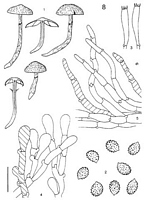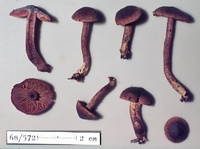|
 Dermocybe egmontiana Dermocybe egmontiana
BiostatusPresent in region - Indigenous. Endemic
Images (click to enlarge)
Caption: Dermocybe egmontiana: 1. carpophores. - 2. spores. - 3. basidia. - 4. cheilocystidia. - 5. pileipellis. - 6. carpophores. | 
Caption: ZT68-572 , Holotype
Owner: E. Horak: © Creative Commons Attribution-Noncommercial 3.0 New Zealand |
Article: Horak, E. (1988) [1987]. New species of Dermocybe (Agaricales) from New Zealand. Sydowia 40: 81-112.
Description: Pileus -25 mm, hemispherical to convex, sometimes umbonate or flat at centre; black to fuscous with chestnut brown tinge, brilliant yellow-orange at margin, conspicuous veil remnants absent; dry, coarsely fibrillose to minutely squamulose, neither hygrophanous nor striate near margin. - Lamellae 16-22, -7, broadly adnate, -4 mm wide; bright orange becoming orange-brown with rust brown tint, edges paler, fimbriate from cheilocystidia. - Stipe -50 x -5 mm, cylindrical or gradually tapering towards base, single; fuscous with red-brown tinge, below fragmentary cortina densely covered with pale orange or yellow fibrils from veil (but without distinct zones or belts); fibrillose, dry, hollow. - Context black or fuscous in pileus, date brown with purplish tint in stipe. - Odour raphanoid. - Taste raphanoid, bitter. - Chemical reactions on pileus: KOH-black with wine red to lilac tint.
Spore print rust brown. - Spores 5.5-6 X 4.5-5 µm, subglobose to ovoid, verrucose, rust brown. - Basidia 20-28 x 6-7 µm, 4-spored, often with wine red plasmatic pigment. - Cheilocystidia conspicuous, composed of cell-chains, terminal cells (15-25 x -10 µm) cylindrical to subclavate, membranes thin-walled, with wine red plasmatic pigment. - Pileipellis a cutis or trichoderm of cylindrical hyphae (5-14 µm diam.), terminal cells cylindrical or subconical, membranes not gelatinized, with wine red to lilac (later turning brown) plasmatic pigment dissolving in KOH. - Clamp connections present.
Habitat: On soil under Leptospermum scoparium (pure stand). - New Zealand.
Notes: D. egmontiana represents another outstanding species of New Zealand’s Dermocybe. The minutely squamulose and dry pilei are black or fuscous at the centre but this colour turns bright yellow near the margin. The orange lamellae are in conspicuous contrast to the dark brown stipe which is densely covered with orange-yellow fibrillose veil remnants. In addition D. egmontiana is characterized by the black-lilac KOH reaction on the surface of the pileus. The fimbriate edges of the lamellae bear large articulate cheilocystidia which, together with the subglobose-ovoid verrucose spores, yield a reliable feature for its safe identification.
The type locality of D. egmontiana is situated in a small remote pure stand of Leptospermum scoparium on the southern slopes of Mt. Egmont. This myrtaceous tree obviously represents the mutual ectomycorrhizal partner for this striking Dermocybe. Finally pigment analysis demonstrated that physcion, emodin and dermocybin (and some of their derivatives) are the most distinctive pigments of D. egmontiana recorded only once with numerous carpophores (KELLER & al., 1988).
|